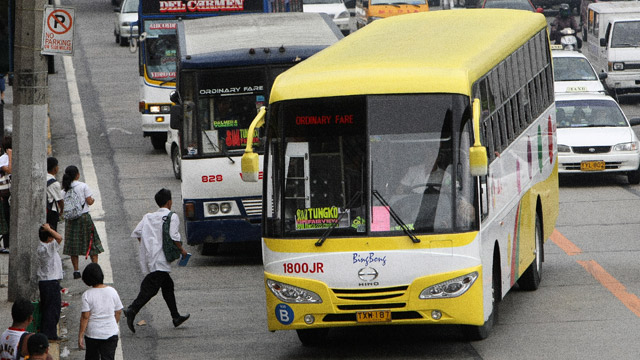SUMMARY
This is AI generated summarization, which may have errors. For context, always refer to the full article.

MANILA, Philippines – A lot has been said about the horrific traffic situation in Metro Manila, especially on EDSA. Social media usually lights up with complaints whenever gridlock clogs the metro’s main artery.
Much of the blame is directed at public utility buses (PUBs) for their supposed lack of discipline on the road. A recent study by the UP National Center for Transportation Studies reveals that it is 6 times riskier to take the bus than to ride your own car when commuting.
But just exactly how reckless are these bus drivers? Are they to blame?
To find out, I examined the effectiveness of the current MMDA Bus Segregation System (BSS) [Editor’s note: We previously identified this as the EDSA Bus Rapid Transit System. We regret the error.] through a simple data-gathering activity.
Where do buses stop?
The BSS, implemented by the Metro Manila Development Authority (MMDA), classifies all buses passing through EDSA into four: Bus A, Bus B, Bus C and Bus P. Each type of bus should load and unload passengers only in their respective bus stations (Bus A can only stop at Bus A stations, for example).
Bus C PUBs can stop in both Bus A and Bus B stations. Meanwhile, Bus P (provincial buses) can only stop in select Bus P stations.

For this data-gathering activity, I boarded Bus C PUBs and made 4 round trips on EDSA from Baclaran in Pasay City to Monumento, Caloocan City. I took note of where buses really load and unload commuters. Findings are plotted in the map below.
Green place markers indicate proper loading and unloading in bus stations, while red-shaded circles show where buses made improper stops outside the designated bus stations.
Based on the data, EDSA buses made a total of only 63 proper bus stops as compared to 356 incorrect bus stops – or nearly 6 improper stops for every proper one.
Most cases of improper loading and unloading were done in the following spots. I listed the number of instances:
- near footbridges that do not have bus stations – 59
- near the stairs of the Metro Rail Transit (MRT) and the Light Rail Transit (LRT) stations – 32
- in front of gas stations – 20
- near intersections where there are stoplights – 15
- in front of provincial bus terminals – 14
Who says where to load and unload? Not only the bus conductor, but also the passengers themselves. Public transport becomes a “private service” for some passengers when they signal bus conductors to stop where they find it convenient to disembark.
There were 35 instances when buses stopped at the correct bus stations, but did not load and unload at these stops. Why is that? Because passengers troop to both ends of the bus stations, not in the middle.
This is a regular scene in Cubao at the southbound side of EDSA where most buses load and unload passengers near the entrance of P. A. Bernardo Street and at the other end of the MRT Araneta Center-Cubao Station stairs, but not at the correct bus station in the middle of it.
In summary:
- EDSA buses stop where the commuters are, whether these commuters wait in correct bus stations or not
- Both the conductor and the passengers “call the shots” insofar as where buses stop
BSS not effective
As for the BSS, bus stations are not put in areas where most buses usually load and unload. There were only a few official bus stations, for example, along the stretch between Balintawak in Caloocan City and SM North EDSA in Quezon City.
To their credit, the MMDA may have studied the logistics for the bus station locations, but the agency may not have factored in the behavior of Metro Manila commuters.
The BSS is also difficult to implement because of the “independence” of bus drivers. When drivers see no commuters in one correct bus station, for example, they skip that station and proceed to the next one.
Contrast this with the bus system in Seoul, South Korea or even the MRT system here in Metro Manila, where the buses and trains stop at every station no matter the volume of passengers.
This “independence” also leads bus drivers to drive outside the designated “yellow lane” for PUBs. The rush to fetch passengers both in proper and improper spots along EDSA prompts bus drivers to find their way to those places, no matter what.
Also, MMDA traffic enforcers are not regularly stationed in every bus station. I also observed that not all MMDA traffic enforcers strictly direct bus drivers to stop in designated stations.
There were even instances when buses unloaded in a wrong spot — in plain view of an MMDA official, but nothing was done to apprehend the erring drivers.
All these daily behaviors, plus about 12,000 buses plying EDSA, can spell only one thing: heavy traffic.
In conclusion, given the 6:1 ratio of incorrect to correct bus stops, the lack of discipline on the part of both bus drivers and passengers (coupled with inconsistent enforcement of traffic rules by MMDA officials), it comes as no surprise that the current EDSA bus segregation system has been failing miserably. – Rappler.com
Add a comment
How does this make you feel?
There are no comments yet. Add your comment to start the conversation.